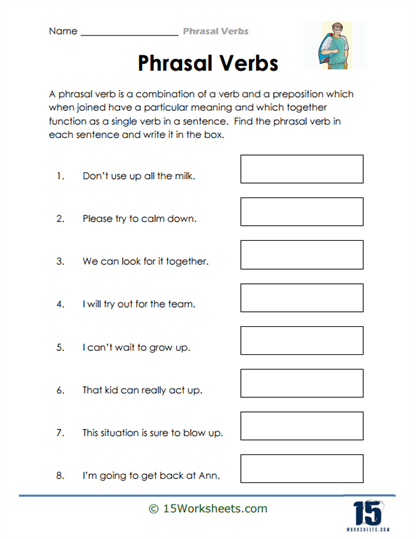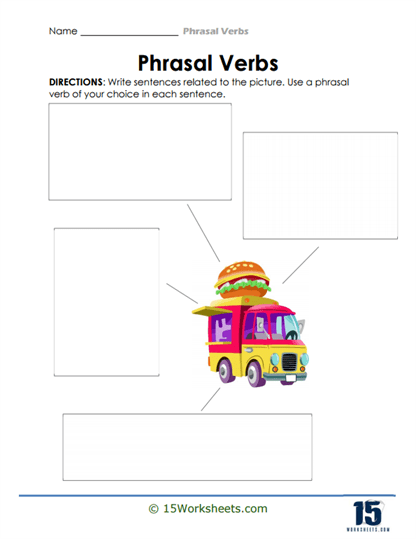Phrasal Verbs Worksheets
About These 15 Worksheets
This collection of worksheets is an essential resource for students, teachers, and homeschoolers aiming to master the nuances of English phrasal verbs. Phrasal verbs are combinations of a verb and one or more prepositions or adverbs that create a specific meaning, often different from the individual meanings of the words involved. Understanding these constructions is crucial for fluency in English, as phrasal verbs are commonly used in both spoken and written language. This comprehensive set of worksheets provides various exercises that cater to different learning styles, ensuring that students can grasp and apply these important language elements effectively.
Key Features and Activities
Identification Exercises – The first type of worksheet in this collection focuses on identifying phrasal verbs within sentences. Students are asked to underline the phrasal verb in each sentence, such as “back up” in the sentence “The evidence did not back up the witness’ statement.” This activity helps students recognize phrasal verbs in context, reinforcing their understanding of how these verb combinations function within a sentence. By repeatedly identifying phrasal verbs, students become more comfortable and familiar with their usage, which is a foundational skill for mastering more complex exercises.
Fill-in-the-Blank Exercises – Another valuable exercise in the collection is the fill-in-the-blank activity, where students are provided with a list of phrasal verbs and must choose the correct one to complete each sentence. For instance, students might need to select “come up with” to fill in the blank in the sentence “I hope something good will ______ this.” This type of activity encourages students to think critically about the meaning of the sentence and the phrasal verb options, reinforcing both vocabulary and comprehension skills. It also allows students to practice using phrasal verbs in various contexts, deepening their understanding of their meanings and applications.
Matching Exercises – The matching worksheets ask students to pair phrasal verbs with their corresponding meanings. For example, students might match “fall apart” with “to break into pieces.” This exercise helps solidify the connection between the phrasal verb and its meaning, making it easier for students to recall and use them correctly in conversation and writing. By providing a direct link between the verb phrase and its definition, this activity enhances vocabulary retention and reinforces learning through repetition and association.
Synonym Selection – In the synonym selection activity, students are tasked with circling the closest synonym to the given phrasal verb from a list of options. For instance, if the phrasal verb is “get along,” students might choose “manage” as the closest synonym. This exercise helps students understand the nuances of meaning between different verbs and encourages them to think about how phrasal verbs compare to other verbs with similar meanings. It also aids in expanding their vocabulary by exposing them to various ways of expressing the same idea.
Multiple-Choice Questions – Another type of worksheet includes multiple-choice questions where students must select the correct phrasal verb to complete each sentence. For example, students might choose between “get over” or “get out of” to complete the sentence “I told him to ______ it.” This format not only tests their knowledge of phrasal verbs but also enhances their decision-making skills as they evaluate which verb fits best within the context of the sentence. It’s a great way to assess their understanding and ensure they are learning the correct usage of each phrasal verb.
Creative Sentence Writing – To encourage creative thinking, some worksheets ask students to come up with their own sentences using specific phrasal verbs. For example, students might be given a verb like “give up” and asked to create a sentence such as “I won’t give up on my dreams.” This type of activity not only reinforces their understanding of how phrasal verbs function in context but also allows them to apply what they’ve learned in a more personal and creative way. Writing their own sentences helps solidify their grasp of phrasal verbs and enhances their ability to use them fluently in both written and spoken English.
Expansion – Another exercise in the collection focuses on expanding students’ knowledge of phrasal verbs by asking them to list as many phrasal verbs as they can think of that start with a particular verb, such as “get” or “take.” This activity challenges students to recall and apply their knowledge, helping to reinforce and expand their vocabulary. It also encourages them to think about how different prepositions or adverbs can change the meaning of a verb, deepening their understanding of how phrasal verbs are formed and used.
Separable and Inseparable – Some worksheets focus specifically on separable and inseparable phrasal verbs, teaching students about the different ways phrasal verbs can be structured. For example, in a sentence like “She handed the evidence over,” the worksheet might ask students to rewrite the sentence to demonstrate the separable nature of the phrasal verb (“She handed over the evidence”). This activity helps students understand the flexibility and rules governing phrasal verb usage, which is crucial for mastering more advanced grammar concepts.
Contextual Understanding – Worksheets that focus on understanding phrasal verbs in context ask students to choose the correct phrasal verb to complete a sentence based on the overall meaning of the sentence. For instance, students might need to decide whether “put up with” or “put away” fits best in the sentence “I won’t ______ your behavior any longer.” This type of exercise encourages students to think about meaning and context, which are essential skills for using phrasal verbs correctly in conversation and writing.
Review Sheets – The collection includes review worksheets that bring together various types of exercises to test students’ overall understanding of phrasal verbs. These might include a mix of identification, fill-in-the-blank, matching, and creative sentence writing activities. Review worksheets are a great way to assess students’ progress and reinforce what they’ve learned, ensuring they have a solid grasp of phrasal verbs before moving on to more complex grammar topics.
From identification and matching exercises to creative sentence writing and contextual understanding, these worksheets cover all the essential aspects of learning phrasal verbs. The variety of exercises ensures that students can practice and reinforce their knowledge in different ways, catering to different learning styles and helping them build confidence in their language skills. Whether you are a teacher looking to supplement your classroom materials or a homeschooler seeking effective resources for language learning, these worksheets provide a comprehensive and engaging tool for mastering phrasal verbs.
What are Phrasal Verbs?
Phrasal verbs are a unique and essential element of English grammar that consist of a verb paired with one or more prepositions or adverbs. These combinations often create a meaning that is different from the individual meanings of the words involved. For instance, when the verb “give” is combined with the preposition “up,” the resulting phrasal verb “give up” takes on a new meaning: “to stop trying” or “to surrender.” This new meaning is not immediately apparent from the individual meanings of “give” and “up,” which illustrates how phrasal verbs can transform simple actions into more complex and nuanced expressions.
The purpose of phrasal verbs in grammar is to enrich the language by allowing speakers and writers to convey ideas more precisely and idiomatically. Phrasal verbs often express actions, conditions, or states of being in a way that single verbs cannot. They bring flexibility and depth to the language, enabling speakers to articulate thoughts and emotions with greater specificity. For example, consider the difference between “run” and the phrasal verb “run out of.” While “run” simply describes the act of moving quickly on foot, “run out of” means to deplete a supply of something, such as when someone says, “We have run out of milk.” This phrasal verb adds context and clarity, showing how the action affects a particular situation.
In everyday communication, phrasal verbs play a significant role because they are commonly used in both spoken and written English. Native speakers often rely on phrasal verbs to express ideas in a casual, conversational tone. For example, instead of saying “I need to cancel my plans,” a native speaker might say “I need to call off my plans.” The phrasal verb “call off” is more informal and fits naturally into everyday speech, making the conversation sound more fluid and relatable. This use of phrasal verbs helps create a connection between speakers by using language that feels familiar and accessible.
Phrasal verbs are not just limited to informal contexts-they are also important in formal writing and speech. In business communication, academic writing, and other professional settings, phrasal verbs are often used to convey specific actions or processes. For example, in a business report, someone might write, “We need to follow up with the client,” using the phrasal verb “follow up” to indicate the action of maintaining contact after an initial meeting. In this context, the phrasal verb is precise and efficient, providing clear instruction while maintaining a professional tone.
However, the widespread use of phrasal verbs also presents a challenge for non-native English speakers, who may find them difficult to learn and understand due to their idiomatic nature. Unlike regular verbs, the meaning of a phrasal verb is not always easily deduced from its components, which can lead to confusion. For instance, someone learning English might struggle with the difference between “look up” (to search for information) and “look after” (to take care of something or someone). These subtle differences highlight the importance of studying phrasal verbs in depth to achieve fluency and comprehension in English.















